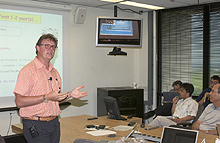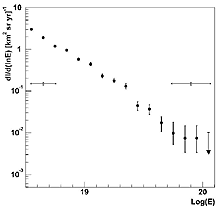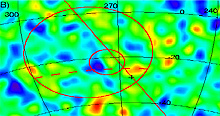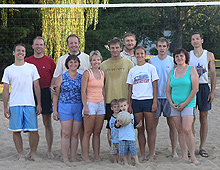 | Wednesday, August 17, 2005 |
|
Wednesday, August 17 3:30 p.m. Director's Coffee Break - 2nd Flr X-Over 4:00 p.m. Fermilab Colloquium - 1 West Speaker: P. James, University of Toledo Title: The Enigmatic Martian Polar Caps Note: There will be no Fermilab ILC R&D Meeting this week
Thursday, August 18 |
|
Extended Forecast |
Secon Level 3 |
|
Wednesday, August 17 Vegetable Beef Soup Quarter Pound Hot Dog in a Soft Shell Pretzel Roll $4.85 Salmon w/Lemon Pepper $3.75 Country Fried Steak with Pepper Gravy $3.75 Beef & Cheddar Panini $4.75 Assorted Personal Pizzas $3.50 Cavatappi Pasta with Italian Sausage & Tomato Ragu $4.85 The Wilson Hall Cafe now accepts Visa, Master Card, Discover and American Express at Cash Register #1. |
|
Wednesday, August 17 Lunch Cajun Shrimp Salad w/Tomatoes & Avocados Pineapple Rum Cake
Thursday, August 18
Chez Leon Menu |
| Fermilab Today is online at: http://www.fnal.gov/today/ Send comments and suggestions to today@fnal.gov Fermilab Today archive Fermilab Today PDF Version Fermilab Result of the Week archive Fermilab Safety Tip of the Week archive Linear Collider News archive Fermilab Today classifieds Subscribe/Unsubscribe to |
|
LHC, Tevatron Scientists Discuss First Years of LHC | ||
| ||
|
Scientists from both the Tevatron and LHC communities gathered on Thursday, August 11, to discuss the turn-on and the first few years of the LHC. The mini-workshop was sponsored by Fermilab's LHC Physic Center (LPC), and focused on a presentation by Michelangelo Mangano of the CERN theory group, who co-authored the article "LHC Physics: The First One-Two Year(s)..." with Fabiola Gianotti, the Deputy Spokesperson of Atlas. Afterward, CDF Spokesperson Young-Kee Kim and DZero Spokesperson Jerry Blazey led a discussion about the topic.
"It was a lively seminar," Blazey said. "There was lots of interaction between the audience and the speaker. There was definitely a level of excitement among the audience." In fact, the mini-workshop filled Wilson Hall's Sunrise Room to capacity, and some audience members had to participate from outside the door or via a videoconferencing system set up a few feet away. Optimistically, physics results could come from the LHC as early as six months after turn-on. "If, as we all hope, there is an obvious, brand-new regime of physics, LHC may reveal signs of it within six months," said Blazey. "But if the data is subtler and needs more investigation, it could take two to three years for meaningful results."
Commissioning large experiments is a long and difficult process, as the CDF and DZero communities know first-hand. "I am pleased that the LHC community is trying to figure out the timeline and the commissioning process, and that they want to use to the experiences from CDF and DZero to help," said Kim. "It's very positive."
|
|
Live from Snowmass: Climbing the GDE Mountain |
|
After huffing and puffing their way up the steep hill to the Top of the Village condos, more than 50 people gathered in the Gatehouse on Tuesday afternoon for the first GDE meeting. “I think that our meeting was scheduled all the way at the top of this hill to prove that if you’re in the GDE, you can climb a mountain,” said GDE Director Barry Barish.
—Elizabeth Clements Read More |
|
Security Testing of Computing Systems |
|
Later this year a team of auditors from the DOE will visit Fermilab to examine the status of our computer security program. One of the exercises during this audit will include penetration testing. Penetration testing involves attempting to gain unauthorized access to our computers without doing any damage. Successful accesses will then be reported to us to help us strengthen our defenses and prevent the same attack in the future. Penetration testing may be accomplished by technical means or by social engineering. Social engineering means using deception to trick users into giving out information—such as your password—that will make it easier to gain unauthorized access to a computing system.
In preparation for that audit, the Fermilab computer security team will soon begin penetration testing. Special arrangements are being made with the owners of systems performing important functions at the lab, such as business services, the accelerator, and the online experimental controls. Those arrangements will allow us to determine the security of the systems without disrupting the service they provide or to postpone the testing until those systems are not required for production service. Most systems at the lab do not fall into this category and will be subject to penetration testing on a continuous basis beginning in the near future.
Future articles will provide some tips on keeping your system safe, and more details on what these tests will include.
|
|
From i-Newswire.com, August 14, 2005 NSF Terminates Rare Symmetry Violating Processes (RSVP) Project At the recommendation of NSF management, the National Science Board, NSF's policymaking body, voted to cancel the RSVP project while it was still in the design stage, due to large increases in both construction and operating costs. The project had been budgeted at about $145 million for construction between Fiscal Year 2005 and 2010. |
| Pierre Auger Observatory: The First Scientific Results | ||
| ||
|
Last week, the Pierre Auger Collaboration presented 36 scientific and technical papers at the 29th International Cosmic Ray Conference in Pune, India. The papers are available online.
The Pierre Auger Observatory, currently under construction in Malargue, Argentina, is a huge observatory for ultra-high-energy cosmic rays. By making simultaneous measurements of the transverse and longitudinal profile of cosmic ray air showers, the Auger scientists were able to empirically calibrate the energy and direction resolution of their detectors. While events with energies above the so-called Greisen-Zatsepin-Kuzmin energy of 5 x 1019 electron volts (eV) were unambiguously found, the current levels of statistical and systematic uncertainties precluded any firm conclusion as to whether the universe is opaque to cosmic rays above this energy. The highest energy event had a Fluorescence-measured energy of approximately 2 x 1020 eV. Anisotropy and point source searches were also performed, but with the present level of statistics, no significant excesses were seen from any direction in the sky. Weak point source signals have been found, however, in the data from several other experiments. Of particular interest is the correlation of cosmic ray arrival directions with distant BL Lac objects as seen in the AGASA, Yakutsk, and HiRes data. Auger will improve by an order of magnitude upon the sensitivity of all existing experiments in the next three years of data-taking. A feasible cosmic ray astronomy program could be just around the corner.
|
|
ILC Newsletter to Launch ILC NewsLine, the International Linear Collider Global Design Effort's newsletter, will release its inaugural issue this Thursday. Sign up for the newsletter at LinearCollider.org.
International Folk Dancing
4th Annual GSA Triathlon
SciTech Holds Duck Race |



